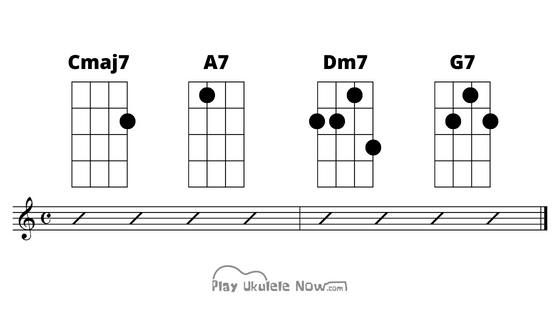You will Learn More and Play More with Play Ukulele NOW.
Find out for yourself why teachers and students have depended on Play Ukulele NOW Methods and Songbooks since 2009
Find out for yourself why teachers and students have depended on Play Ukulele NOW Methods and Songbooks since 2009
DISCLOSURE: THIS POST MAY CONTAIN AFFILIATE LINKS, MEANING I GET A COMMISSION IF YOU DECIDE TO MAKE A PURCHASE THROUGH MY LINKS, AT NO COST TO YOU. PLEASE READ MY DISCLOSURE FOR MORE INFO.
Find all my chord related posts here: Chord Tips and Tricks
Previously we learned about how to use Major 6 chords, Major 9 chords, and 6/9 chords, we learned how that are great substitutes (embellishments for) for the I or the IV chord.
We also learned that those major chords may not be substituted for a V chord, although a V chord is a major chord when a scale is harmonized with major and minor chords it is not a major chord when we harmonize a scale with 7 chords - it's a dominant, so the best choice for a V chord substitute is a dominant chord.
Best (most popular) choices for a I or IV substitute (embellishment)
The major 9 #11 is the last in this series of great substitutes for the I or the IV. As we learned previously - there are 4 chords that make the best and most popular choices for a major chord. There are many other options but if you're just getting into chord substitution - these are great ones to start with.
Best choices for I or IV substitute (embellishment):
- 6 (major 6)
- Major 9
- 6/9 (this is a major chord as well)
- Major 9 #11
Next up will be minor substitutes so stay tuned and check back so you don't miss any installments in this series...
Check out the major 9 #11 (take a listen)
Let's check out the major 9 #11 and see how it sounds...
Listen to it compared to the major 7.
This is a great choice if your looking for something different - notice the slightly unresolved cool floating sound it has.
About the major 9 #11
Let's take a look at the major 9 #11 chords.
These may be familiar forms to you if you've used major 7 chords - they are the same forms.
Major and dominant 11 chords typically have a #11 because of the dissonance created with the major 3rd and the 4th. The #11 solves that problem, the 11th (which is actually the 4th tone) is then 1 step away from the major 3rd rather than 1/2 step.
The major 9 #11 is built with 6 tones the root note (1), a major 3rd (3), a perfect 5th (5), a major 7th (7), the 9th tone (9), and the #11th (#11).
The root is raised to get the 9th tone, so there is no root and either the 5th of the 3rd will be altered to get the #11th tone...
There are two ways to make the Major 9 #11 we could lower the 5th 1/2 step to get the #11 or we could raise the 3rd 1 step. Here we raise the 3rd to get the easy to play familiar chords we see here.
Rules to remember:
- If you take a major 9 chord and raise the 3rd 1 step so that it becomes the #11 you get the major 9 #11 chord.
- A major 9 #11 is the same cord as a major 7 chord a 5th higher (so a C major 9 #11 is the same chord as the G major7)
GRAB YOUR (PDF) MAJOR 9 #11 CHORD CHARTS HERE (Charts show MAJOR 9 #11 chords all the way up the neck) and a COOL CHEAT SHEET HERE (patreon)
How to use them
The major 9 #11 may be substituted for the I or the IV chord.
For the progressions that follow try strumming each chord slowly (1 slow strum for each chord) and then go on to the next chord. Listen to the beauty of each chord - also play the with two strums per chord as indicated, repeat each progression a number of times.
Let's take a look at a ii V I progression...
PROGRESSION 1 - ii V I harmonized with 7 chords:
In this progression we can substitute a major 9 #11 for the I chord (which is C major 7); take a look:
PROGRESSION 2 - ii V I with the major 9 #11 for the I chord:
Play progression 1 a number of times (repeating it etc...)
Then play progression 2 - listen closely to the difference... What do you think?
Now lets take a look at a I VI ii V progression, we changed the quality of the VI like we did in the previous lessons.
PROGRESSION 3 - I VI ii V harmonized with 7 chords:
PROGRESSION 4 - I VI ii V with the major 9 #11 substituted for the I chord:
We can use the major 9 #11 for the IV chord as well...
PROGRESSION 5 - I VI IV V Harmonized with 7 chords:
PROGRESSION 6 - I VI IV V with the major 9 #11 substituted for I & IV:
You can always slip one of these in somewhere for effect as well.
Try using it in some places but not others.
"Pin me" you 'Ukulele Friends' will want to see this"















.png)


No comments:
Post a Comment